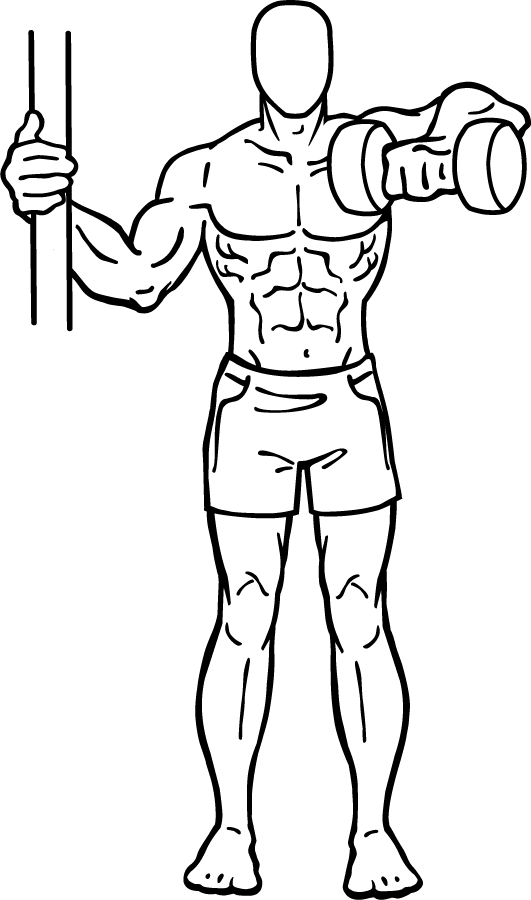Last Updated on December 27, 2002
The One Arm Upright Row is a powerful exercise designed to target and strengthen your shoulders and trapezius muscles. This single-arm movement allows you to isolate each side of your body, ensuring balanced muscle development and symmetry. If you’re looking to build broad shoulders and a strong upper back, the One Arm Upright Row should be a go-to exercise in your workout routine.
In this comprehensive guide, we’ll dive deep into the benefits, anatomy, step-by-step execution, variations, and common mistakes to avoid in the One Arm Upright Row. With the right form and focus, this exercise can elevate your shoulder and upper back strength to the next level.
Why the One Arm Upright Row?
The One Arm Upright Row offers numerous benefits for strength training enthusiasts, from isolating and building specific muscles to improving posture. Here’s why it’s a great addition to any workout:
- Isolates the Shoulders and Trapezius: By focusing on one arm at a time, this exercise allows you to isolate the deltoids and trapezius muscles, enhancing control, strength, and muscle growth.
- Corrects Muscle Imbalances: Training each arm separately ensures balanced strength and development, which is essential for both aesthetics and injury prevention.
- Enhances Shoulder Stability: Strong deltoids and trapezius muscles contribute to overall shoulder stability, crucial for overhead and pushing movements.
- Improves Posture: Building strength in the upper back and shoulders helps counteract the effects of poor posture, especially for those who sit for long periods.
- Increases Range of Motion: The One Arm Upright Row helps to improve your shoulder’s range of motion, which can benefit other exercises and daily activities.
Anatomy of Muscles Targeted in the One Arm Upright Row
Understanding the muscles worked in the One Arm Upright Row can help you optimize form and maximize muscle engagement:
- Deltoids (Shoulders):
- The deltoids are responsible for shoulder movement and come into play during the upward rowing motion. The exercise mainly targets the anterior (front) and lateral (side) heads of the deltoid muscle.
- Trapezius (Upper Back):
- Located in the upper back, the trapezius helps stabilize and move the shoulder blades. It is heavily activated in this exercise, especially during the top portion of the lift when the dumbbell is close to shoulder height.
- Rhomboids and Levator Scapulae:
- These smaller muscles of the upper back assist the trapezius in stabilizing the scapula (shoulder blade), promoting better posture and upper body stability.
With this exercise, you’ll not only develop the appearance of broader shoulders but also support functional strength for various lifting and athletic movements.
Step-by-Step Guide: How to Perform the One Arm Upright Row
Equipment Needed: A dumbbell
1. Setting Up
- Choose a Dumbbell: Start with a moderate weight that you can lift with control. Beginners should aim for lighter weights to master the movement.
- Position Yourself: Stand next to a sturdy post, wall, or another stable object to support your balance.
2. Starting Position
- Grip the Post for Stability: Use one hand to hold the post or stable object, ensuring your body remains upright and balanced throughout the movement.
- Hold the Dumbbell: With your other hand, grasp the dumbbell using a pronated grip (palms facing backward), and hold it in front of your thigh.
- Stand Tall: Maintain a straight posture with your core engaged, feet hip-width apart, and knees slightly bent for stability.
3. Execution
- Lift the Dumbbell: Exhale and lift the dumbbell upward, keeping it close to your body. Lead the movement with your elbow, raising it to shoulder height and pointing it away from your body.
- Feel the Contraction: As you reach the top, you should feel a contraction in your shoulder and trapezius muscles. Pause briefly at the top to maximize muscle engagement.
- Lower with Control: Inhale as you slowly lower the dumbbell back down to the starting position, maintaining control and avoiding any jerky movements.
4. Repeat
- Perform 10-15 repetitions for one arm before switching to the other. Aim for 3-4 sets to fully work the target muscles.
Tips for Maximizing the One Arm Upright Row
- Lead with Your Elbow: Focus on lifting your elbow rather than the dumbbell itself. This helps target the shoulders and trapezius muscles more effectively.
- Avoid Over-Lifting: Do not lift the dumbbell above shoulder height, as this can put unnecessary strain on the shoulder joint.
- Controlled Movements: Move the dumbbell in a controlled manner to ensure the muscles, not momentum, are doing the work.
- Breathing: Exhale on the upward lift and inhale as you lower the weight back down.
- Engage Your Core: Keeping your core tight will help stabilize your body and maintain proper form.
Common Mistakes to Avoid in the One Arm Upright Row
Avoiding common mistakes is key to performing this exercise safely and effectively:
- Shrugging the Shoulder: While it’s natural to feel the trapezius working, avoid excessive shrugging, as this can strain your neck and reduce the engagement of your shoulders.
- Using Excessive Weight: Start light and gradually increase the weight. Overloading can compromise form and put undue stress on the shoulder joint.
- Raising Above Shoulder Height: Bringing the dumbbell above shoulder level can increase the risk of impingement in the shoulder. Keep the motion limited to shoulder height.
- Using Momentum: Avoid swinging the dumbbell. Focus on slow, controlled lifts and descents to maximize muscle engagement and safety.
- Elbow Dropping During Lift: Ensure your elbow stays higher than your hand throughout the movement to effectively target the trapezius and shoulders.
Benefits of the One Arm Upright Row
The One Arm Upright Row is a versatile and effective exercise with numerous benefits, including:
- Balanced Shoulder Development: Training one arm at a time ensures each shoulder is evenly developed.
- Improved Posture: Strengthening the shoulders and upper back helps correct postural imbalances, especially beneficial for those who spend a lot of time seated.
- Enhanced Muscle Definition: This exercise helps create well-defined shoulders and a strong upper back.
- Functional Strength: Strong shoulders and traps play a critical role in everyday activities like lifting and carrying objects.
- Joint Stability: Strengthening the muscles around the shoulder joint reduces the risk of injury and provides support during other upper body exercises.
Variations of the One Arm Upright Row
Incorporating variations can help target different angles, activate additional muscles, and keep your routine fresh. Here are some effective variations:
- Cable One Arm Upright Row:
- Perform the exercise using a cable machine, which provides continuous tension. Attach a single handle to the cable and set the pulley at a low height for a similar movement pattern.
- Kettlebell One Arm Upright Row:
- Using a kettlebell instead of a dumbbell can change the exercise’s dynamic, as kettlebells require more stabilization and core engagement.
- Seated One Arm Upright Row:
- Sit on a bench to eliminate leg stabilization, allowing you to focus more on your shoulders and trapezius. This variation is helpful for those with lower back issues.
- Incline One Arm Upright Row:
- Position yourself at a slight incline to target the upper traps and shoulders from a different angle. This setup also engages the core more actively.
- Dual Dumbbell Upright Row:
- Use two dumbbells and lift both arms simultaneously. This version allows for heavier weights and is effective when you want to emphasize volume over strict unilateral movement.
Integrating the One Arm Upright Row into Your Routine
Including this exercise in your workout routine is simple. Consider adding it to your upper body or shoulder day. Here’s a sample workout:
- Warm-Up:
- Start with 5-10 minutes of light cardio followed by dynamic shoulder stretches to warm up the rotator cuffs and trapezius muscles.
- Sample Shoulder Workout:
- Dumbbell Shoulder Press: 4 sets of 8-10 reps for overall shoulder strength.
- Lateral Raises: 3 sets of 12 reps to focus on the lateral deltoid.
- One Arm Upright Row: 3 sets of 10-15 reps per arm to isolate and target the trapezius and shoulder.
- Face Pulls (Cable): 3 sets of 12 reps to target the rear delts and upper back.
- Shrugs: 3 sets of 10-12 reps for trapezius strengthening.
- Cool-Down:
- Perform static stretching focused on the shoulders, upper back, and neck to promote flexibility and recovery.
Adjustments for Different Fitness Levels
Beginners:
- Use a lighter weight and focus on mastering form. Start with 2-3 sets of 12-15 reps per arm for muscle endurance.
Intermediate:
- Increase the weight slightly and perform 3 sets of 10-12 reps per arm. Experiment with variations, like the cable version, for added resistance.
Advanced:
- Use a heavier weight, aiming for 4 sets of 8-10 reps. You can also add supersets, pairing the One Arm Upright Row with another shoulder exercise to increase intensity.
Enhancing the Mind-Muscle Connection
Developing a strong mind-muscle connection during the One Arm Upright Row will maximize muscle activation:
- Visualize the Target Muscles: As you lift, focus on your shoulders and traps contracting and lengthening.
- Slow Down the Tempo: Moving slowly increases time under tension, helping you feel the muscle activation more.
- Lighten the Load: Start with a lighter weight and gradually increase as you feel the connection improving.
Safety Considerations for the One Arm Upright Row
To ensure safety while performing this exercise, follow these guidelines:
- Use Proper Form: Correct form is essential to prevent shoulder impingement and neck strain. Always prioritize form over weight.
- Avoid Overloading: Start with a manageable weight and progress gradually. The shoulders and trapezius are susceptible to injury when overloaded.
- Warm Up Properly: Cold muscles are more prone to strain. Perform a thorough warm-up to prepare your shoulders and upper back.
- Avoid Overuse: Since this exercise focuses on the shoulder and trapezius, limit it to once or twice per week, allowing adequate rest between sessions.
A Recap of the One Arm Upright Row
The One Arm Upright Row is a powerful exercise that can improve shoulder and trapezius strength, balance upper body muscles, and enhance overall shoulder stability. Here’s a recap of its benefits and tips to get the most out of it:
- Balanced Shoulder Development: Training each arm individually ensures symmetry and balanced strength.
- Improved Posture and Stability: Strengthening the upper back and shoulders helps counteract poor posture.
- Enhanced Shoulder Mobility: Regular practice can increase shoulder flexibility, benefiting other exercises and daily movements.
Whether you’re a beginner or an advanced lifter, incorporating the One Arm Upright Row into your routine can help elevate your shoulder and upper back strength. By prioritizing form and control, this exercise will bring you closer to stronger, more defined shoulders and a robust upper back. Make the One Arm Upright Row a staple in your training for well-rounded upper body development and better overall fitness.








